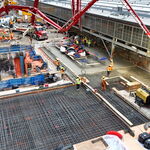You're clearly looking at this from the traditional perspective of what GO is, a commuter rail line where people travelling from the suburbs can use the train to reach the CBD and get to work. The problem is this isn't what GO RER is or is supposed to be. Imagine if LSW was renamed to "Line 7", Kitchener to "Line 8", Barrie to "Line 9", etc. That's what GO RER is. Imagine for a second that we used the same argument to remove the fare integration between the subway and TTC busses, claiming that the subway is meant for suburbanites travelling to the CBD to get to work, which to some extent is true, there is a massive amount of people from York Region that commute every day to Finch Station to take the subway down to Union. However, we both know that even though a large chunk of the Subway's ridership comes from these commutes, it comes nowhere close to the amount of Torontonians that use the Subway for their needs. The same applies to GO RER. Imagine, if you will, commuting from Parkdale to downtown. Instead of riding Line 2 all the way down to St. George, and transferring to Line 1, they can transfer to Bloor-Dundas West, and take GO down to Union on the same fare they paid for the subway. The amount of Torontonians this would single-handedly benefit is absolutely massive. Imagine if Line 6 was extended south from Humber College to the new Woodbine GO station, and GO had full fare integration with the TTC. Status Quo dictates that the people that live in North Western Toronto, areas around Albion Mall, have to travel down Line 6 to Finch West, which is estimated to take 25-30 mins, then spend an additional 34 minutes travelling on Line 1, or around a 1h commute. Instead they can spend around 10 minutes taking Line 6 to Woodbine, then transfer to the GO train and reach downtown in 19 minutes (this is according to the IBC which claims that with GO RER, travel times from Etobicoke North to Union will be 16 minutes, so I added 3 mins for how long it would take to travel 2km, based off the additional 3 mins the IBC claims it will take to reach to Union from Maple compared Rutherford, 2 stations that are also 2km apart). This is one isolated example, but its so important to state how beneficial GO RER would be to many communities within Toronto that are currently transit deserts, New Toronto, Scarborough (basically all of eastern and northern Scarborough for that fact), Rexdale, Weston, the list goes on. To say that RER will serve those outside of Toronto more than those in Toronto, while accurate to some extent, really misses the point of what RER is and what its supposed to be.
P.S. Keep in mind the argument is mostly to follow TRBOT's Fare Zone proposal, not to make the entire GO train network a single fare with the TTC. That would be ludicrous, nobody is arguing for that.




